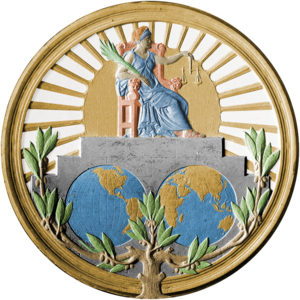The Statute of the International Court of Justice is an integral part of the United Nations Charter, as specified by Chapter XIV of the United Nations Charter, which established the International Court of Justice (replacing the Permanent Court of International Justice).
YouTube Encyclopedic
-
1/5Views:3 19821 40748840 292619
-
statute of ICJ | international court of justice | law gat
-
22 Introduction to Article 38
-
Statute of ICJ ( International Court of Justice) - International law for law gat / Law Gat lectures
-
International Court of Justice (ICJ) - Explanation and Analysis
-
STATUTE of International Court of Justice ICJ (Full)
Transcription
Structure
The Statute is divided into 5 chapters and consists of 70 articles. The Statute begins with Article 1 proclaiming:
"The international Court of Justice established by the Charter of the United Nations as the principal judicial organ of the United Nations shall be constituted and shall function in accordance with the provisions of the present Statute."
— [1]
The 69 Articles are grouped in 5 Chapters:
- Chapter I: Organization of the Court (Articles 2 - 33)
- Chapter II: Competence of the Court (Articles 34 - 38)
- Chapter III: Procedure (Articles 39 - 64)
- Chapter IV: Advisory Opinions (Articles 65 - 68)
- Chapter V: Amendment (Articles 69 & 70)
Article 38.1 lists sources that the court may apply to decide a case, including: treaties, customary international law, general principles of law, and (as subsidiary means) judicial decisions and academic writing. These sources are qualified by Article 59 which states that ICJ decisions are binding only to the parties in that case, and Article 38.2 which allows the court to decide a case ex aequo et bono if the parties agree thereto.
Parties to the Statute

| Parties upon becoming a UN member Parties prior to joining the UN under Article 93 UN General Assembly non-member observer states which are not parties |
All 193 UN member states are parties to the Statute by virtue of their ratification of the UN Charter. Under Article 93(2) of the UN Charter, states which are not a member of the UN may become a party to the Statute, subject to the recommendation of the United Nations Security Council and approval of the United Nations General Assembly. As of 2015, neither the UN General Assembly non-member observer states, namely the State of Palestine and the Holy See, nor any other states are parties to the statute under these provisions. Switzerland (1948-2002), Liechtenstein (1950-1990), San Marino (1954-1992), Japan (1954-1956), and Nauru (1988-1999) were all parties to the Statute prior to becoming UN member states.[1][2]
References
- ^ "Chapter I - Charter of the United Nations and Statute of the International Court of Justice: 3 . Statute of the International Court of Justice". United Nations Treaty Series. 2013-07-09. Retrieved 2013-07-09.
- ^ Search here for "Art 93" to find a series of documents that list every non-UN member that became a party to the ICJ Statute.
External links
- Statute of the International Court of Justice.
- Procedural history note and audiovisual material on the Statute of the International Court of Justice in the Historic Archives of the United Nations Audiovisual Library of International Law

